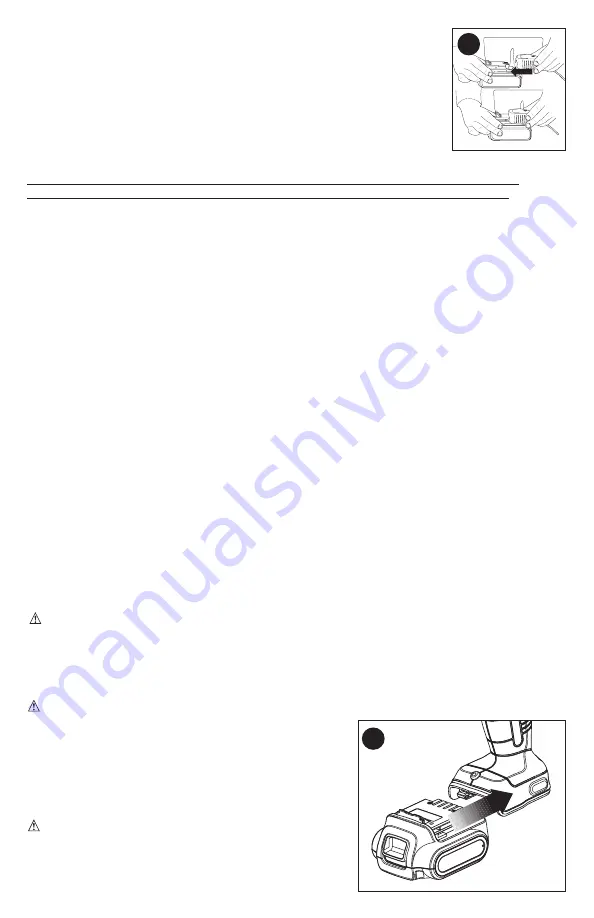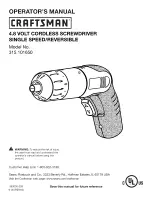
7
cHARGING PRoceduRe
BlAck+deckeR
chargers are designed to charge
BlAck+deckeR
battery packs in 7-8 hours depending on the pack being charged.
1. Plug the charger into an appropriate outlet before inserting the
battery pack.
2. Slide the battery pack into the charger as shown in
figure A.
3. The green LED will flash indicating that the battery is being charged.
4. The completion of charge is indicated by the green LED remaining
on continuously. The pack is fully charged and may be used at this
time or left on the charger.
Recharge discharged batteries as soon as possible after use or battery life may
be greatly diminished. for longest battery life, do not discharge batteries fully.
It is
recommended that the batteries be recharged after each use.
leAvING THe BATTeRy IN THe cHARGeR
The charger and battery pack can be left connected with the green LED glowing
indefinitely. The charger will keep the battery pack fresh and fully charged.
IMPoRTANT cHARGING NoTeS
1. Longest life and best performance can be obtained if the battery pack is charged
when the air temperature is between 65°F and 75°F (18°- 24°C). DO NOT charge the
battery pack in an air temperature below +40°F (+4.5°C), or above +105°F (+40.5°C).
This is important and will prevent serious damage to the battery pack.
2. The charger and battery pack may become warm to touch while charging. This is a
normal condition, and does not indicate a problem. To facilitate the cooling of the battery
pack after use, avoid placing the charger or battery pack in a warm environment such
as in a metal shed, or an uninsulated trailer.
3. If the battery pack does not charge properly:
a. Check current at receptacle by plugging in a lamp or other appliance
b. Check to see if receptacle is connected to a light switch which turns power off
when you turn out the lights.
c. Move charger and battery pack to a location where the surrounding air
temperature is approximately 65°F - 75°F (18°- 24°C).
d. If charging problems persist, take the tool, battery pack and charger to your
local service center.
4. The battery pack should be recharged when it fails to produce sufficient power
on jobs which were easily done previously. DO NOT CONTINUE to use under these
conditions. Follow the charging procedure. You may also charge a partially used pack
whenever you desire with no adverse affect on the battery pack.
5. Foreign materials of a conductive nature such as, but not limited to, steel wool,
aluminum foil, or any buildup of metallic particles should be kept away from charger
cavities. Always unplug the charger from the power supply when there is no battery
pack in the cavity. Unplug charger before attempting to clean.
6. Do not freeze or immerse charger in water or any other liquid.
WARNING:
Shock hazard
. Do not allow any liquid to get inside charger.
Never
attempt to open the battery pack for any reason. If the plastic housing of the battery pack
breaks or cracks, return to a service center for recycling.
SAfeTy WARNINGS ANd INSTRucTIoNS: dRIllS
1. Hold drill firmly with one hand on the grip and the other hand on the bottom of the tool.
2. When attaching accessories in the drill chuck, hand tighten the keyless chuck firmly.
WARNING:
Drill may stall (if overloaded or improperly used) causing a twist. Always
expect the stall. Grip the drill firmly with both hands
to control the twisting action and prevent loss of control
which could cause personal injury. If a stall does
occur, release the trigger immediately and determine
the reason for the stall before re-starting.
INSTAllING ANd ReMovING THe
BATTeRy PAck fRoM THe Tool
WARNING:
Make certain the lock-off button is
engaged to prevent switch actuation before removing or
installing battery.
To INSTAll BATTeRy PAck:
Insert battery pack
into tool, until an audible click is heard (
figure B)
.
A
B








































